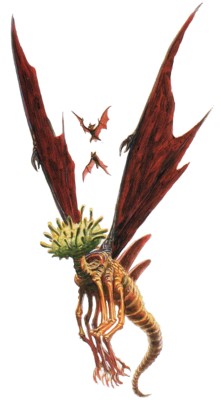Carnivorous Fungi Trapped in Amber
![]() I misunderstood the press release that I quoted last night; the amber in which this carnivorous fungus was found came not from Mexico but from "the highly fossiliferous amber deposit of Archingeay/Les-Nouillers in southwestern France..." It was a more recent and less complete organism previously found in Mexican amber. I apologize for my error.
I misunderstood the press release that I quoted last night; the amber in which this carnivorous fungus was found came not from Mexico but from "the highly fossiliferous amber deposit of Archingeay/Les-Nouillers in southwestern France..." It was a more recent and less complete organism previously found in Mexican amber. I apologize for my error.
In any case, the find is reported in the Brevia of todays Science magazine. It's a relatively quick read of one page plus supporting material which focuses on describing the fungus. Morphologically, the organism doesn't appear to be closely related to any of the fungi with a similarly carnivorous lifestyle extant in the world today. Most interestingly, the lassos in this ancient nematode-roper are composed of only a single cell, whereas all living carnivorous fungi have three-celled snares. Moreover, blastospores (asexually-derived spores created by budding) are found in the specimen, suggesting a yeast-like life cycle. The combination of septate hyphae with the presence of blastospores suggests that this fungus was making a transition from an aquatic to a terrestrial environment. As the article notes, modern carnivorous fungi are considered secondarily aquatic; this one may have been primarily aquatic.  If it were me with this intriguing bit of amber in my sweaty hands, I would try to get some DNA out of the specimen. It would be very interesting to sequence the ribosomal regions to determine which extant fungi it's related to, if any. I'd also try to pull chitinase gene sequences and look at the active site. It would be a nice data point to have in terms of reconstructing an ancestral chitinase gene in the fungi. Perhaps the researchers at Humboldt would like to send me their unique and invaluable find for the weekend so that I could drill a couple of holes into it?
If it were me with this intriguing bit of amber in my sweaty hands, I would try to get some DNA out of the specimen. It would be very interesting to sequence the ribosomal regions to determine which extant fungi it's related to, if any. I'd also try to pull chitinase gene sequences and look at the active site. It would be a nice data point to have in terms of reconstructing an ancestral chitinase gene in the fungi. Perhaps the researchers at Humboldt would like to send me their unique and invaluable find for the weekend so that I could drill a couple of holes into it?
I didn't think so.
This is certainly a great find, in any case, that sheds light not only on the evolution of fungi but also on that of soil ecosystems. I hope that further investigation will take place, particularly if more specimens become available. A molecular analysis seems like a must! Moreso because we cannot be certain from the paper as presented that the snares were actually snares. The sticky secretions found on them could have had other functions (adhering to substrate, for example). And while it's interesting to speculate based purely on morphology that the fungus was making a transition between environments, having some reliable molecular evidence with which to reconstruct its phylogeny would give us far more better evidence of whether or not this is really the case.
Carnivorous Fungi from Cretaceous Amber. Alexander R. Schmidt, Heinrich Dörfelt, and Vincent Perrichot (14 December 2007). Science 318 (5857), 1743. [DOI: 10.1126/science.1149947]





